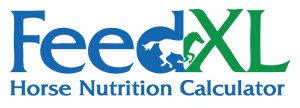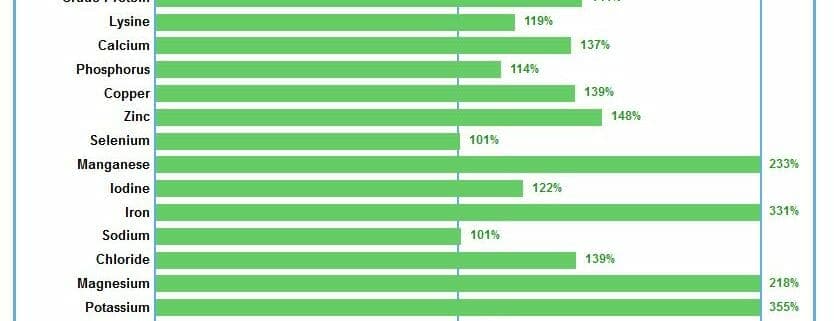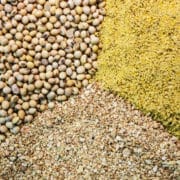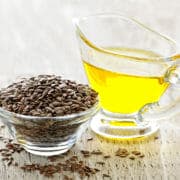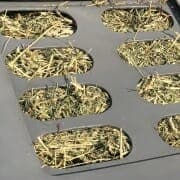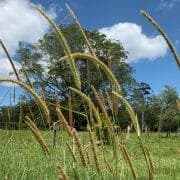Q: Do You Need to Get Every Nutrient to 100% On the FeedXL Graph?
A: No. And in fact, it would be impossible to create a diet that had every nutrient in FeedXL exactly at 100% of your horse’s requirements.
Q. So if not 100%, where should the nutrient levels be sitting? And what is normal? Because some of the amounts on this graph look really high?! Isn’t that dangerous???
A. Good question! And the answer is it depends on the nutrient. Forages, for example, contain high levels of some nutrients like iron and potassium. Because diets often have lots of forage, these nutrients will almost always be high in the diet.
BUT that doesn’t mean it is dangerous. In fact, if you push a nutrient to a dangerous level, FeedXL will warn you – the bar for that nutrient will turn red, like this, to warn you that the nutrient is now at its ‘upper safe limit’ and needs to be reduced.
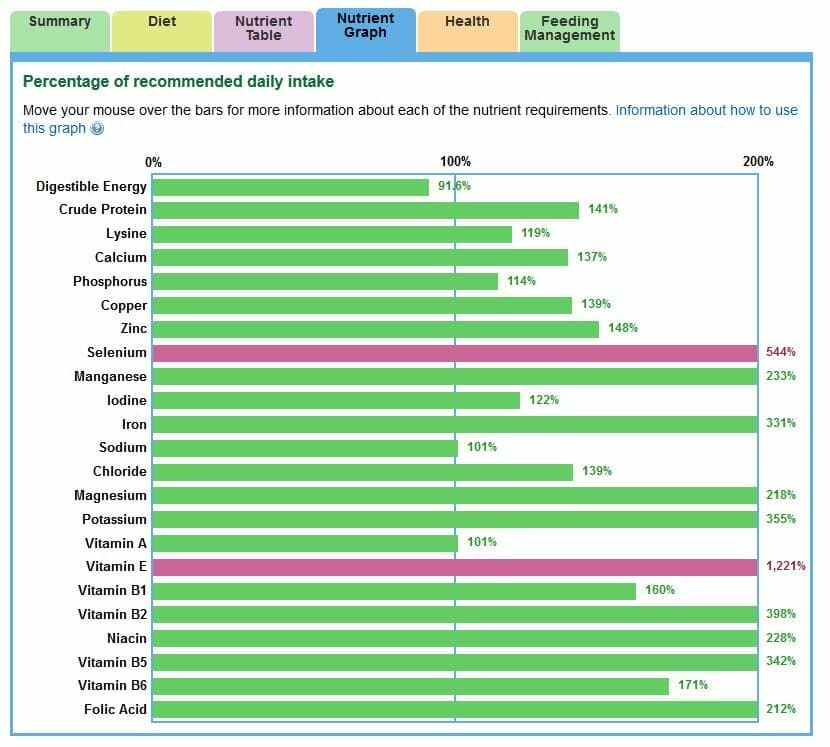
Q. OK, that’s good! So, I know if I get a nutrient WAY too high FeedXL will warn me. BUT I still don’t know what is normal for all of the nutrients. Where should I expect to see them?
A. Yep, let’s walk you through them! We’ll use this graph and go through each nutrient.
Digestible Energy
This should sit, for most horses, somewhere between 90% and 105% of requirements. SOME horses have a lower or higher need for digestible energy (calories) so you may see the odd horse sitting below 90% or above 105%.
BUT, if you do enter a horse and the Digestible Energy is low or high and this does not correspond accurately with what you are seeing in your actual horse (meaning if the Digestible Energy is low in the diet you enter into FeedXL, normally you would expect to see weight loss. If it is high, normally you would expect to see weight gain) you MAY need to double check the information for this nutrient that you have entered into FeedXL as this is a small red flag that something has not been entered right.
For example, if you have entered bodyweight that is too high, the Digestible Energy level will be low and vice versa. Or if you haven’t weighed your feeds and hay or classified your pasture correctly and you have entered amounts or qualities that are too low, then Digestible Energy will appear low and vice versa.
Quick Tip: If Digestible Energy in your horse’s diet is below 90% or above 105%, check that you have entered your horse’s bodyweight and weights of feed and forages correctly. You can also refer to this article on How to Check if What You’ve Entered into FeedXL is Correct which can guide you a bit further on getting it right.
Crude Protein
The Crude Protein level in the diet should always be at or above 100% when entering this nutrient into FeedXL. And it is best to try to keep it less than 200%. For performance horses that are stabled and in work try to keep Crude Protein below 160% if you can… it is not always possible!
Depending on your forages, you may see Crude Protein go very high (well above 200%). Is this an issue? Generally it’s not, but there are some situations (like very hot, humid climates or when a horse is stabled) that it is not ideal. Sometimes, if it is your pasture for example that is high in protein, there is not a lot you can do about it. If the horse is stabled and fed hay, you should try to switch some of the higher protein forage (e.g. alfalfa/lucerne) for a lower protein forage (like a meadow/grass hay), to bring the overall amount of Crude Protein in the diet down.
For detailed information on whether too much protein is an issue or not read our article here: https://feedxl.com/37-protein-can-you-feed-too-much/
Lysine
Lysine is your indicator of protein quality (you can read about Protein Quality here https://feedxl.com/30-understanding-protein-quality/). When entering this nutrient into FeedXL, Lysine should sit between 100% and 150%. If it is lower, it indicates your protein quality is low and your horse will struggle to do things like build muscle or make milk. In fact, when lysine is low in a diet you will likely see your horse losing muscle over his topline… it’s an important nutrient to get right in the diet.
Lysine may get quite high in some diets depending on the amount and source of crude protein. But if you follow the guidelines above for Crude Protein, you will find Lysine levels will adjust accordingly.
Calcium
Calcium should be at or above 100% in the diet and it’s good to keep it below 200%. Ideally, below 150% but depending on the feeds and forages being used, it is not always possible to achieve this. The amount in the diet shown here is lovely, more than the horse needs but well below 200%.
It is important with calcium to also check the calcium to phosphorus ratio in the diet (look in the Nutrient Table) to make sure it is within the right limits with phosphorus. And if you like to use the extra ratios, you can also check its ratio with magnesium, which as a guide, should be 3: 1 or less.
Phosphorus
Phosphorus should be at or above 90% and ideally below 150%. You may see some diets with high phosphorus ingredients like Rice Bran pushing phosphorus higher than this. If it is above 150%, be sure to check the calcium to phosphorus ratio on the nutrient table to make sure this is still balanced (there MUST be more calcium in a diet than phosphorus).
NOTE: You cannot calculate the diet’s calcium to phosphorus ratio off the numbers on the graph. It is always best to read the ratio off the nutrient table. FeedXL will warn you if the calcium to phosphorus ratio is too high or low!
Copper, Zinc, Selenium and Iodine
We group these trace minerals together because they all share the same characteristic that they are almost ALWAYS at low levels in forages. Which means they are nearly always deficient in diets before you add fortified feeds or supplements.
This means that you can aim to keep these nutrients as close to 100% as possible. The diet shown here uses a single vitamin/mineral supplement to meet trace mineral requirements.
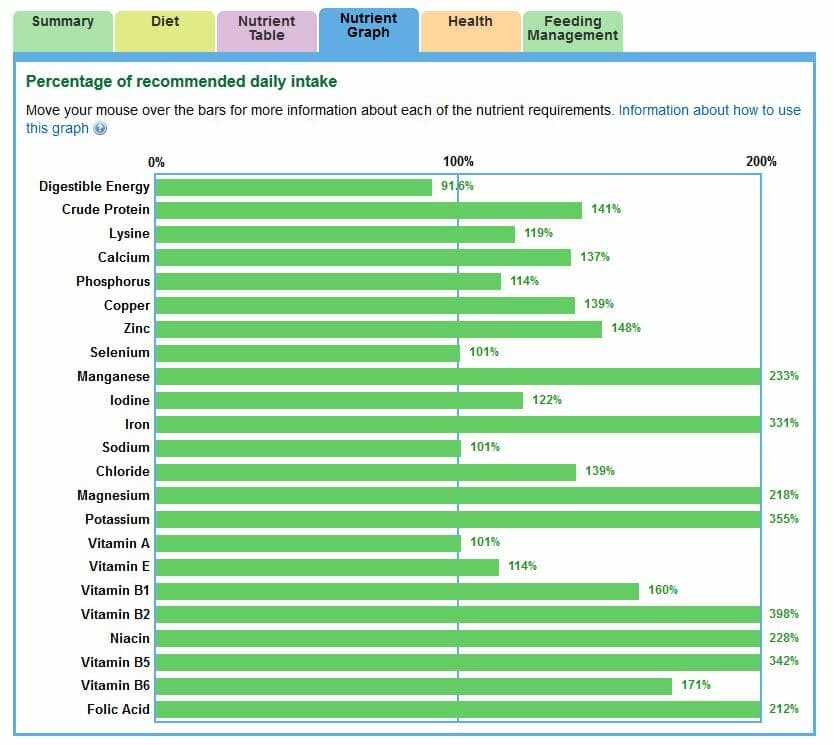
This is what the diet looked like before I added the supplement:
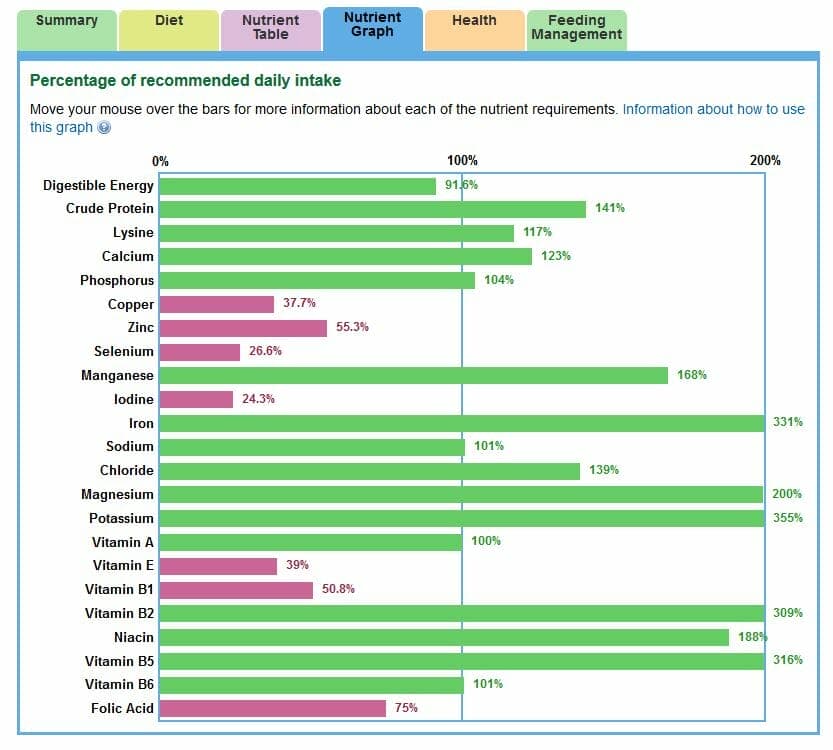
You can see these 4 minerals are all low. I used the Supplement Finder (i.e. the BIG PINK BUTTON on the Results Step) to find a supplement that would fill all of these gaps. Ideally what you want to see when you use a single supplement is that at least one of these minerals is sitting very close to 100%. That is your green flag that you have the amount of supplement at the right level. Increasing the amount from this point is just a waste as all requirements are already met, while reducing it would mean the amount of this nutrient (selenium in this example, which is sitting at 101%) would no longer be meeting requirements.
The same rules also apply when using a fortified feed to meet vitamin and mineral requirements. Except that you also have to consider the amount of Digestible Energy the feed is adding.
This is not a super simple concept, so if you are confused, please keep asking questions, as the more you understand this, the easier it will be to use FeedXL effectively.
Quick tip: You can try to keep copper, zinc, selenium and iodine as close to 100% of requirements as possible. If these nutrients are above 200%, I would be trying to find ways to reduce them. This may mean switching feeds or supplements!
Manganese, Iron, Magnesium and Potassium
These minerals are almost always HIGH in forages. Therefore, you will almost always see them sitting well above your horse’s 100% level in the diet. Is this a concern? No. There are always exceptions, but for the majority of horses, no, it is not a problem when these minerals are well above 200%.
Thing is, because these nutrients are rich in forages, it is almost impossible to get them closer to the 100% mark. You could reduce the amount of forage, but the downside of that (higher risk of ulcers, boredom, compromised hindgut health, higher risk of dehydration and colic) far outweighs any potential upside. In fact unless levels in the forage are extreme and the bar for a nutrient goes red, there really is no upside to reducing forage.
If you are concerned, because sometimes it does look scary, just read the notes in the FeedXL Nutrient Table or the hover box on the graph to put your mind at ease. For example, Iron in this diet is at 331%. Which seems really high! But, the notes will tell you:
“While this horse’s iron is higher than it needs to be it is still within the safe range. His upper safe level for iron is 6,019 mg or 943% of his RDI”
So, the upper safe limit is 943%. This diet is a long way off that, so even though 331% seems high, it is very much within the safe zone!
For those of you who like to look at the iron: copper: zinc: manganese ratio, it is calculated for you in the Nutrient Table.
Sodium and Chloride
Sodium and chloride are the two components of ordinary table salt. So together they can make a feed taste very salty. If a feed gets too salty your horse may stop eating it, because it simply doesn’t taste good (and can’t blame them!). So, I like to keep sodium as close to 100% as I can, by adjusting the amount of salt in the diet.
There are a few exceptions. If your horse is in a very hot and humid climate you may need to feed more (more info here https://feedxl.com/40-electrolytes/) or if you are trying to increase water intake for some reason, more salt is useful. But under normal conditions, sitting sodium at or very close to 100% is best. BUT also, always make sure your horse has access to free choice salt!
Chloride is a bit of a lucky dip and its final level in a diet will depend on the amount in your forages. I don’t pay too much attention to where chloride ends up. In fact I don’t think I have ever had to adjust a diet specifically to change the level of chloride (for any dairy nutritionists reading this, it does play a big role in DCAD, but that is another story for another day 🙂 ).
Vitamin A
If you are obsessive about getting nutrients close to 100% in your FeedXL nutrient chart, Vitamin A is your friend! You will notice it is nearly always sitting on 100% of requirements. Why?
Well, in forage, the ‘vitamin A’ content is not active vitamin A. It is in the form of Beta Carotene which can be converted to vitamin A IF your horse needs vitamin A. So, they will only convert it if they need it.
FeedXL models this physiology and takes into account ALL vitamin A from feeds and supplements as this will be an active form of vitamin A (which can become toxic, so we need to count all of it). But then FeedXL will only convert vitamin A to active form from forages IF your horse needs more vitamin A.
For example, if your feed + supplement provides 80% of your horse’s requirement for vitamin A, FeedXL will just top up the remaining 20% of vitamin A from forages to meet 100% of your horse’s requirement. Which is why Vitamin A is very often sitting right on 100%.
If your feeds and supplements provide more than 100% of your horse’s requirement for vitamin A you will see it above 100%. This is OK, as long as it is within safe limits (though personally I would keep it under 200%).
Vitamin E, Vitamin B1 and Folic Acid
These three are grouped together because they will often be low in diets before you add some kind of fortified feed or supplement. And they are all relatively expensive nutrients, so for the sake of cost, you want to make sure your horse’s requirement is met, but if levels of these vitamins go above 200%, you may be paying a lot for nutrients your horse doesn’t really need. Keep them between 100% and 200% if you can. In the case of this diet, the supplement used was rich in Folic Acid, so it has tipped above 200%, but the E and B1 are at nice levels so nothing to worry about with the Folic Acid in this case.
Quick Tip: Keeping these nutrients below 200% will make sure the diet is not excessively expensive!
Vitamin B2, Niacin, Vitamin B5 and Vitamin B6
This crew are all grouped together because forage is OFTEN high in these vitamins so you will normally see levels WELL ABOVE 100% for all of these vitamins. Is that something you should be concerned about? Not at all. In fact all of these except vitamin B6 are considered non-toxic. And the vitamin B6 upper safe level is very high (in this diet the upper safe limit is 5000%!!).
Quick Tip: You can ignore these nutrients as long as they are ‘green’. They will almost always be well above 100%, but it is nothing to be concerned about!
I hope that helps you a little to read the graph and to put your mind at ease about what is and is not normal for certain nutrients. If you have questions, please be sure to ask in the FeedXL Horse Nutrition Forum on Facebook!! We truly want you to know as much as you can about what FeedXL is showing you!
Do you have a question or comment? Do you need help with feeding?
We would love to welcome you to our FeedXL Horse Nutrition Facebook Group. Ask questions and have them answered by PhD and Masters qualified equine nutritionists and spend time with like-minded horse owners. It’s free!
Click here to join the FeedXL Horse Nutrition Facebook Group
